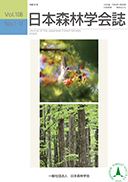
- |<
- <
- 1
- >
- >|
-
Yusuke Doi, Wataru Ishii, Nobuyuki Ogata, Nobuyuki Aiko2024Volume 106Issue 5 Pages 117-127
Published: May 01, 2024
Released on J-STAGE: May 16, 2024
JOURNAL OPEN ACCESSTo elucidate the effect of intensive thinning on surface erosion, we conducted monthly measurements of forest floor cover and soil movement in thinning and control plots over a period of 3 years in three stands each of Cryptomeria and Cypress and one Oak stand. In the Cryptomeria stands, both thinning and control plots exhibited forest floor cover exceeding 60% and a low level of fine earth movement. In the Cypress stands characterized by low forest floor cover, the thinning plots showed high fine earth movement immediately after heavy thinning; however, this difference gradually diminished over 3 years. In the Oak stand, both thinning and control plots displayed high forest floor cover and minimal fine earth movement immediately after heavy thinning. However, erosion occurred in both plots after 2 years, and was attributed to the activities of numerous boars excavating the ground while foraging roots and acorns. This suggests a significant impact of wild animals, particularly wild boars, on surface erosion. These findings indicate that the Cryptomeria and Oak stands exhibit a high level of resistance to surface erosion. Conversely, forests inhabited by wild boars and with Cypress stands with low forest floor cover are prone to surface erosion immediately after heavy thinning.
View full abstractDownload PDF (3528K) -
Atsushi Seino, Hiroshi Ono2024Volume 106Issue 5 Pages 128-139
Published: May 01, 2024
Released on J-STAGE: May 16, 2024
JOURNAL OPEN ACCESSAssessing flood and landslide risk requires estimating moisture dynamics in forest soils on a slope-by-slope basis. In this study, a soil-moisture variability model based on a tank model was developed using easily accessible data. The accuracy of the model in reproducing moisture distribution and variability according to forest characteristics was verified. The model comprised a canopy interception representing the aboveground portion and a series tank model representing the belowground portion. The purpose of the model was to simulate the variability in soil moisture at midslope depths of 10, 30, 50, and 100 cm on a forest slope. The model integrates the effects of soil pore composition and water absorption by tree root systems on water movement. The model parameters were established based on data collected from 2021. Subsequently, without changing the parameters, the model was tested using the rainfall data from 2020. The results of an assessment of the modelʼs reproducibility demonstrated that the model could reproduce soil-moisture variability with high accuracy. The modelʼs calculations of the canopy interception rate and evapotranspiration accurately reflected the depth-specific variability in soil moisture. The model was shown to be suitable as a forecasting tool, although it was necessary to integrate seasonal variations in evapotranspiration.
View full abstractDownload PDF (1958K) -
A Case Study at the “OHAYASHI”, a Mixed Forest on Manazuru Peninsula.Takashi Masaki, Tamotsu Sato, Tsutomu Yagihashi, Gaku Hitsuma, Takuto ...2024Volume 106Issue 5 Pages 140-144
Published: May 01, 2024
Released on J-STAGE: May 16, 2024
JOURNAL OPEN ACCESS
J-STAGE DataCrown width and crown eccentricity distance were measured for black pine, camphor tree, and chinquapin trees ranging from 60 to 200 cm in stem diameter at breast height (DBH) in the “OHAYASHI”, an old-growth mixed forest on the Manazuru Peninsula in Kanagawa Prefecture, Japan. The maximum crown width for each species ranged from 1,570 cm for black pine to 3,200 cm for camphor tree, and the crown eccentricity distance ranged from 550 cm for black pine to 1,050 cm for camphor tree. Crown width tended to increase with DBH for the black pine and camphor tree. Crown eccentricity distance tended to decrease with DBH in black pine, but slightly increase in the hardwood species. In the hardwood species, crown width was positively correlated with DBH growth, suggesting that the crown width could be an indicator of the vitality of old and large-diameter trees. In the study site, which is mainly gently sloping, the correlation between crown eccentricity distance of hardwoods and slope angle was unclear. We noted that more information on canopy width and canopy plasticity needs to be collected in order to properly manage young stands with the goal of restoring old-growth and large-diameter hardwood forests.
View full abstractDownload PDF (948K)
- |<
- <
- 1
- >
- >|